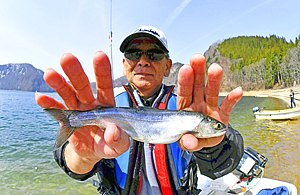Long-awaited lifting of ban on kokanee fishing met with joy(待望ヒメマス漁解禁)

KANEYAMA, Fukushima - Amateur anglers flocked to Lake Numazawa in Kaneyama, Fukushima Prefecture, in early April when a four-year ban was lifted on fishing for kokanee (see below), the lake's specialty. The ban was imposed following the 2011 disaster at Tokyo Electric Power Company Holdings Inc.'s Fukushima No. 1 nuclear power plant.
「ずっと待ち望んでいた」。東京電力福島第1原発事故の影響で自粛が続いていた金山町の沼沢湖特産のヒメマス漁が9日、解禁された。
The resumption of fishing brought smiles to the faces of those who had been working to that end and to the recreational fishermen who had gathered on the day fishing resumed. Anglers came not only from neighboring areas but also from outside the prefecture.
"We've waited for this day for a long time," one angler said.
A large number of people came to the lake, which is known as the prefecture's only habitat for kokanee, and were absorbed in fishing from early morning.
県内で唯一のヒメマス生息地となる同湖にはこの日、県内外から大勢の釣り人が集結。50匹以上釣り上げた人もいるなど、約4年ぶりの"復活"に、関係者と釣り人の笑顔が広がった。
沼沢湖の岸には早朝から多くの釣り人が訪れ、思い思いに釣りざおを垂らした。
"It's so good to see so many anglers coming," said a smiling Shigeru Suzuki, 66, the head of the Numazawa fishermen's cooperative, who decided to lift the fishing ban.
「大勢の釣り人が来てくれてうれしい」。漁解禁を決めた沼沢漁業協同組合長の鈴木茂さん(66)の表情には自然と笑みがこぼれた。
Kokanee fishing in the lake, which began in the Meiji era (1868-1912), has a history of more than 100 years. As the population of the fish does not greatly increase through natural breeding, the fishermen's cooperative has been spending more than \1 million a year to collect their roe, hatch them and release 100,000 to 190,000 juvenile fish into the lake.
Such efforts began before the 2011 Great East Japan Earthquake. The expense was covered by fees for commercial use of gill nets and fees for recreational fishing.
明治以来100年以上の歴史がある同湖のヒメマス漁は一時、危機に立たされていた。自然繁殖では個体数の大きな増加が見込めないため、同漁協は震災前から毎年百数十万円をかけて、採取した卵から飼育した稚魚10万~19万匹を湖に放流。その経費は、漁で使う刺し網の行使料や釣り遊漁料でまかなってきた。
The earthquake and the ensuing accident at the nuclear power plant forced the cooperative to ban kokanee fishing in April 2012. If the ban had been prolonged, the community could have lost the local tradition.
その中で東日本大震災と原発事故が発生。2012(平成24)年4月から続く自粛が長引けば、こうした伝統が途切れる可能性もあった。
Levels of radioactive cesium in the kokanee of the lake have been below the government-set threshold of 100 becquerels per kilogram since August 2014.
"We are concerned about negative rumors about Fukushima products possibly spreading, but we want to keep offering kokanee to many people," Suzuki said.
14年8月以降、同湖のヒメマスは食品の放射性セシウムの基準値(1キロ当たり100ベクレル)を下回っており、鈴木さんは「風評への懸念は残るが、これからも多くの人にヒメマスを提供できるようにしたい」と意気込む。
Anglers have also been looking forward to the lifting of the ban. A 71-year-old recreational fisherman from Tochigi Prefecture caught more than 50 fish on the day the ban was lifted and said with a smile: "I've been longing to fish for kokanee here. I'm so happy the ban was lifted."
愛好家も、解禁を待ち望んでいた。栃木県から訪れた茂木美賀さん(71)はこの日、50匹以上を釣り上げた。「漁再開をずっと要望してきた。再開はうれしい」。待望の解禁を喜んだ。
Finding successors key
The town of Kaneyama has been using kokanee as a tourism draw through such ways as making kokanee burgers and preparing the fish as oshizushi (pressed sushi). However, the local fishery industry now faces the challenge of finding successors because some fishermen who had been catching kokanee with gill nets have retired due to old age and for other reasons.
後継者育成に課題
ヒメマスは「ヒメマスバーガー」や押しずしにされ、金山町の観光資源として活用されてきた。しかし、刺し網漁でヒメマスを提供してきた漁師が高齢などを理由に引退したため、後継者育成が課題となっている。
The members of the Numazawa fishermen's cooperative jointly conduct gill-net fishing while intensifying efforts to nurture successors.
Yuichi Meguro, 57, a chief director of Okuaizu, a group of local companies that have been working to attract tourists with oshizushi and other specialty dishes, expressed concern.
"We need a lot of fish in the tourist season in autumn," he said.
押しずしなどを観光客に振る舞ってきた企業組合おく愛ズの目黒祐一理事長(57)は「秋の行楽シーズンにはまとまった魚の数が必要になる」と頭を悩ませる。沼沢漁協は当面、刺し網漁を漁協で行い、後継者育成も急ぐ考えだ。
■ Kokanee
A small sockeye salmon that does not migrate out to the sea but spends its entire life in freshwater such as lakes. In Japan, this fish is mainly found in Hokkaido. The high-quality fish is known for being the tastiest member of the salmon family, with less of a fishy odor and more of a deep, rich flavor. After the 2011 disaster, an inspection conducted by the Numazawa fishermen's cooperative detected 202 becquerels per kilogram of radioactive cesium in kokanee taken from Lake Numazawa, which exceeded the government-set threshold. The cooperative, therefore, banned kokanee fishing in 2012. It lifted the ban this year after the fish's radiation level fell and remained below the threshold.
( Translated by The Japan News )
■ ヒメマス
海に下ることなく湖などにとどまるベニザケ。北海道を中心に分布する。サケ類で最も味が良いとされる高級魚で、臭みが少なく濃厚なうま味が特徴。沼沢湖では一時、食品の基準値(1キロ当たり100ベクレル)を上回る202ベクレル(沼沢漁協検査)の放射性セシウムが検出され、2012(平成24)年から漁などの自粛が続いていたが、基準値を安定的に下回ったとして解禁された。
【 2016年4月10日・本紙掲載 】
- Futaba Post Office reopens after 13 years(双葉郵便局、13年ぶりに再開)
- Craft sake brewery to make unmanned station more welcoming(無人駅の「クラフトサケ」醸造所がお出迎え)
- New Kitakata ramen developed to appeal to foreign tourists(訪日客向けの喜多方ラーメン開発)
- Aizu-Wakamatsu students come together with teahouse project(会津若松の生徒、茶室プロジェクトに集結)
- New hotel to be symbol of reconstruction(復興のシンボルとなる新ホテル)
- Radiation-resistant cameras to be produced in Fukushima(耐放射線カメラ、福島県で生産へ)
- International flights to Fukushima to resume after 13-year hiatus(福島の国際定期便、13年ぶり再開へ)
- Fukushima association to create base for parents of children with disabilities(障害児の親へ拠点作り)
- Real shell mound from Jomon period goes on display in Minami-Soma(南相馬で縄文のリアル貝塚展示)
- Japanese man opens restaurant to provide free meals to residents of war-hit Ukraine city(日本人男性が戦禍のウクライナに無料レストラン開店)